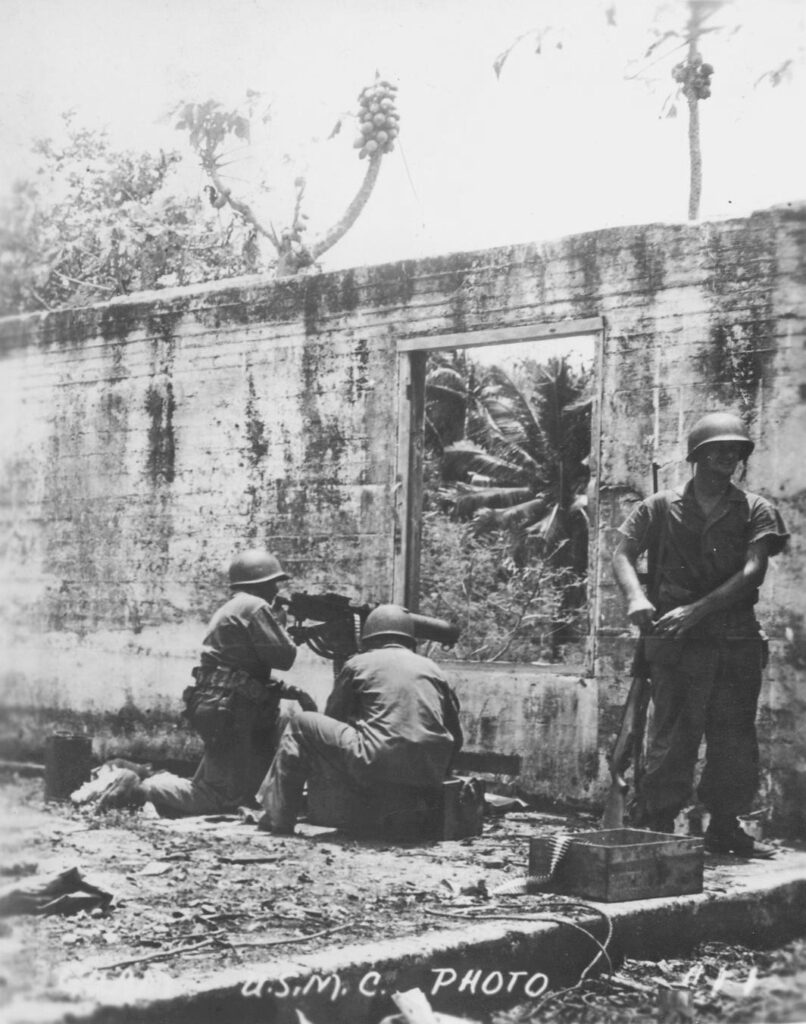With the American forces entrenched on Saipan, the plan had already been set for the taking of Guam.
As the American forces dealt with the remaining Japanese troops on Saipan, they had set their sights on bombarding Guam. By July, the bombings continued on a more regular basis.
According to Admiral Nimitz’ diary, on July 16, 1944, less than a week before the invasion, air strikes and ship bombardment of Guam continued and produced “excellent results” with negligible opposition.
Afternoon reconnaissance on 15 July (K) of reef edge at southern beaches (GUAM) provoked considerable fire of up to 5 or 6-inch caliber; 1 officer was killed and 5 enlisted men were slightly wounded; resulting disclosure of enemy emplacements enabled BB gunfire at 3,000 yards to demolish battery on BANG! POINT, while ships plus LCI’s with rockets and automatic weapons beat down fire from beaches. Reconnaissance showed coral heads obstructing approach to Yellow and White beaches (immediately south of OROTE PENINSULA), especially the latter; reef edge is irregular; coral heads can probably be cleared successfully to provide approach for LCM’s and LCT’ s.”
On July 16, Task Group 58.2 flew 74 sortie over Guam target areas dropping 28 tons plus 24 rockets and 20 incendiary clusters.

“We lost one plane but pilot and crew were saved,” the admiral’s diary stated.
The bombardment of the beaches intensified.
The damages to coast defense and dual purpose guns sustained during the bombardment would now permit uninterrupted approach to landing beaches when supported by counter battery fire, the book said.
Around July16-17, removal of underwater obstacles was underway. A total of 71 sorties were flown over the target area by July 17 where 38 tons of bombs and 37 rockets were dropped.
By July 18, the landing beaches and adjacent areas had been thoroughly covered by naval and air bombardment. Clearance of reef obstacles continued.
On the same day, assets of the Task Force 58 converged and concentrated on Guam.
Admiral Nimitz wrote in his diary, “1,020 sorties were flown over the target area, and 400 tons of bombs and 140 rockets were dropped; we lost 5 planes and 3 crews. On the 19th strikes by TF 58 continued against Guam; reports from TGs’ 58.2 and 58.3 show 535 sorties over the target area expending 225 tons of bombs; no plane loss was reported.”
By July 19, 1944 (Oahu time), the landing forces were ready.
“Task Force 53 commences landing operations against GUAM at 0830 (K) 21 July. 1st Marine Division lands regiments abreast on beaches at ASAN with immediate objective of securing APRA HARBOR. 1st Marine Provisional Brigade (4th and 22nd Marine Regiments) with one RCT (305tb) of 77th Inf Div will land on beaches at AGAT with immediate objective of seizing OROTE PENINSULA. 77th Inf Div (less, one RCT), remaining as floating reserve is scheduled to land on 23 July (K).”
It was reported that progress continued with the clearance of obstruction and preparation of the reefs.
The Gray Book said there was heavy “interdiction fire” day and night to prevent replacement of obstacles.
“Destruction of shore defenses has proceeded as scheduled with heavy close range gunfire and powerful air strikes,” wrote Nimitz.
Admiral Nimitz’ diary also stated negligible defense at the beach by this time; however, it underscored the need to prepare for the unexpected for the “mobile artillery which has not fired and which has not been located.”
As of July 19, there were a total of 1,008 sorties flown against Guam and dropping over 400 tons of bombs.
Nimitz had chronicled the actual landings:
20 July (Oahu Date)
Landings on GUAM took place on all beaches according to schedule commencing at 0830 (K) 21 July. Landings were made against light opposition only and mostly on southern beaches. CTF 53 in a despatch to CTF 58 stated that air strikes during the past four days had left nothing to be desired. On 20 July (K) TF 58 sent l,302 sorties over GUAM target areas, dropping 894 tons of bombs and 115 rockets; we lost 2 planes with crews in combat and 3 planes operationally. On the 21st TG’s 58.1, 58.3, and 58.4 flew 582 sorties over GUAM target areas and dropped 215 tons of bombs and 67 rockets; 1 plane with crew was lost in combat and 3 planes (2 with crew) were lost operationally. TG 58.2 stands by for call strikes.
Task Force 53 reported that the assault forces landed on Guam “with absolute precision and according to schedule,” all assault units and their weapons, including tanks and artillery, had been landed by 1800 (K) 21 July.
“Initial opposition was nominal but stiffened as troops advanced,” wrote Nimitz.
Further on the Guam landing, Nimitz stated in his diary: “Initial waves at southern beaches received some mortar fire prior to the landing; on the northern beaches such fire was not received until after several waves had landed. Casualties are unreported but believed moderate. Gunfire and air support which preceded the landings was reported by CTF 53 as being unsurpassed. TG 68.2 which supported the landing did much to keep enemy artillery fire to the minimum; during the day this group dropped 90-tons of bombs and expended 248 rockets. Called fires from fire support ships have been used freely; illumination and harassing gunfire will be furnished during the night 21-22 July (K). Good beach heads have been secured though it is expected that enemy artillery fire on the beach heads may be troublesome during the night. Unloading of essential supplies will continue to capacity of beaches. RCT 305 (77th Inf Div) was landed afternoon 21 July (K) over southern beaches; it is planned to land remaining 2 RCTs of 77th Inf Div over the same beaches on 22 July (K) if beach conditions and the tactical situation permit.”
As they continued to secure the island of Guam, another group was simultaneously intensifying its attack on Tinian in preparation for the July 24 landings that would begin on White Beaches, 3 miles southwest of Ushi Point.
On July 22 (Oahu Date), the Guam operation was proceeding “satisfactorily.”
“As of 1800 (K) 23 July 2 RCT’s of 77th Inf. Div. and all of corps artillery had been landed,” was stated in Nimitz’s Gray Book, noting that there was heavy enemy counter attack against the eastern part of the northern beachhead. This was repulsed, the diary said, with “effective air, naval gunfire and artillery support.”
Based on the Volume 5 of Admiral Nimitz’ Gray Book, the beachhead on the south includes Mt. Alifan. It was also reported that the road leading from Agana to Piti had been placed under American control.
The road up to Mt. Tenjo was in American hands as well.
As of 4 p.m. on July 23, the American forces reported the following casualties: 348, killed in action; 1,500, wounded in action; and 110, missing in action.
The report acknowledged that these figures could be incomplete.
As for the Japanese forces, the Gray Book said there were 948 known dead and there could be “many more.”

On July 24, the ground forces’ operations were slowed down by the fierce Japanese resistance on the eastern flank of the northern area.
“Progress was slow,” according to Nimitz’ logs.
The diary underscored the progress the Americans had been making in the south as Orote Peninsula had been completely cut off even with considerable opposition.
“On 25 July (K) operations of our ground forces on GUAM proceeded satisfactorily
In the northern area the enemy resistance inland from ADELUP POINT is being overcame and our progress there has accelerated. Near the base of OROTE PENINSULA the enemy has organized a center of resistance to oppose its occupation; the forces comprising this resistance are isolated from the remainder of enemy forces. Our troops in the extreme south are meeting little resistance and their advance is limited by considerations of over extension rather than by opposition. Naval gunfire and bombing continue active in close support of our troops. 1st Provisional Marine Brigade will launch a coordinated attack against the hostile forces on OROTE PENINSULA on 26 July (K),” Nimitz stated in his diary.
The left flank of the American’s northern perimeter rested on the shore line at Adelup Point with the right flank at a point 2,000 yards south of Piti. “The depth of the perimeter averages about 2,000 yards,” the book said.
In the wake of the bombings and the assault on Guam, the Americans had lost 443 as of 4 p.m. on July 24, 1944. There had been 2, 366 wounded in action and 209 missing in action.
By that time, the Americans had had reported 2,399 dead Japanese “and there are undoubtedly many more.”
By July 26, Guam operations had proceeded satisfactorily.
The 1st Marine Provisional Brigade waged an attack against the Japanese forces at Orote Peninsula on the morning of July 26.
There had been an attempt by the enemies to escape the peninsula the night before.
There was a heavy attack by the Japanese on the south near the harbor side; however, this was broken up by artillery fire leaving in its wake 400 dead Japanese.
By July 26, the Americans had lost 587 men killed in action; 2,798, wounded; and 191, missing.
By this time, there were 2,783 confirmed Japanese dead.
The capture of Orote Peninsula was completed on July 29 afternoon.

According to the Admiral Nimitz’ Gray Book: “The port and airfield programs are now in full swing. Elsewhere on GUAM, our front lines remain unchanged, activity being limited to patrolling; patrols are reaching out to a distance of 2500 yards along the entire front and are meeting few enemy. One patrol reached the E central shore without encountering the enemy.”
By July 30, casualties had reached 948, killed in action; 2,650, wounded; 138, missing.
Of the 948 killed in action, 555 were from the 3rd Marine Division; 51, 77th Infantry Division; 331, 1st Provisional Brigade; 4, Corps Arty; and 7, Garrison Troops.









